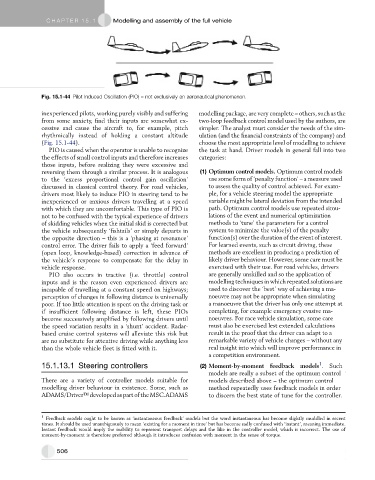Page 498 - Automotive Engineering Powertrain Chassis System and Vehicle Body
P. 498
CHAP TER 1 5. 1 Modelling and assembly of the full vehicle
Fig. 15.1-44 Pilot Induced Oscillation (PIO) – not exclusively an aeronautical phenomenon.
inexperienced pilots, working purely visibly and suffering modelling package, are very complete – others, such as the
from some anxiety, find their inputs are somewhat ex- two-loop feedback control model used by the authors, are
cessive and cause the aircraft to, for example, pitch simpler. The analyst must consider the needs of the sim-
rhythmically instead of holding a constant altitude ulation (and the financial constraints of the company) and
(Fig. 15.1-44). choose the most appropriate level of modelling to achieve
PIO is caused when the operator is unable to recognize the task at hand. Driver models in general fall into two
the effects of small control inputs and therefore increases categories:
those inputs, before realizing they were excessive and
reversing them through a similar process. It is analogous (1) Optimum control models. Optimum control models
to the ‘excess proportional control gain oscillation’ use some form of ‘penalty function’ – a measure used
discussed in classical control theory. For road vehicles, to assess the quality of control achieved. For exam-
drivers most likely to induce PIO in steering tend to be ple, for a vehicle steering model the appropriate
inexperienced or anxious drivers travelling at a speed variable might be lateral deviation from the intended
with which they are uncomfortable. This type of PIO is path. Optimum control models use repeated simu-
not to be confused with the typical experience of drivers lations of the event and numerical optimization
of skidding vehicles when the initial skid is corrected but methods to ‘tune’ the parameters for a control
the vehicle subsequently ‘fishtails’ or simply departs in system to minimize the value(s) of the penalty
the opposite direction – this is a ‘phasing at resonance’ function(s) over the duration of the event of interest.
control error. The driver fails to apply a ‘feed forward’ For learned events, such as circuit driving, these
(open loop, knowledge-based) correction in advance of methods are excellent in producing a prediction of
the vehicle’s response to compensate for the delay in likely driver behaviour. However, some care must be
vehicle response. exercised with their use. For road vehicles, drivers
PIO also occurs in tractive (i.e. throttle) control are generally unskilled and so the application of
inputs and is the reason even experienced drivers are modelling techniques in which repeatedsolutions are
incapable of travelling at a constant speed on highways; used to discover the ‘best’ way of achieving a ma-
perception of changes in following distance is universally noeuvre may not be appropriate when simulating
poor. If too little attention is spent on the driving task or a manoeuvre that the driver has only one attempt at
if insufficient following distance is left, these PIOs completing, for example emergency evasive ma-
become successively amplified by following drivers until noeuvres. For race vehicle simulation, some care
the speed variation results in a ‘shunt’ accident. Radar- must also be exercised lest extended calculations
based cruise control systems will alleviate this risk but result in the proof that the driver can adapt to a
are no substitute for attentive driving while anything less remarkable variety of vehicle changes – without any
than the whole vehicle fleet is fitted with it. real insight into which will improve performance in
a competition environment.
1
15.1.13.1 Steering controllers (2) Moment-by-moment feedback models . Such
models are really a subset of the optimum control
There are a variety of controller models suitable for models described above – the optimum control
modelling driver behaviour in existence. Some, such as method repeatedly uses feedback models in order
ADAMS/DriverÔ developedaspart oftheMSC.ADAMS to discern the best state of tune for the controller.
1 Feedback models ought to be known as ‘instantaneous feedback’ models but the word instantaneous has become slightly muddled in recent
times. It should be used unambiguously to mean ‘existing for a moment in time’ but has become sadly confused with ‘instant’, meaning immediate.
Instant feedback would imply the inability to represent transport delays and the like in the controller model, which is incorrect. The use of
moment-by-moment is therefore preferred although it introduces confusion with moment in the sense of torque.
506

